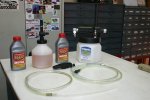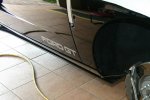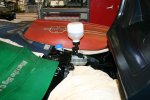This post should be read in conjunction with posts entitled Brake Bleeding Systems, Ford GT Tech, page 4 and Rookie gets knocked off Pedestal Today, Ford GT Tech, page 3. These are the only two posts I found on brake bleeding. I believe there are additional posts on clutch bleeding without the use of a power bleeder.
CONCLUSION:
In early June after discussions with professional mechanic friends, the Snap On guy and research on this forum I purchased a Mityvac vacuum bleeder that operates off a shop compressor. I bled both the brakes and clutch system on my Ultima and my Ford GT, without the assistance of a second person. The system worked as promised. I was impressed. www.mityvac.com I have no financial interest in this company. Model MV 6835 will contain all the necessary gear to bleed both the brakes and clutch on the Ford GT. The Mityvac sites lists the stores which carry their products, however, I was not able to locate the model I was looking for (one with a couple of more options than MV 6835 that I later determined were unnecessary for my purposes) from any of the stores listed. Finally, Fran purchased the kit for me off eBay. She has the eBay account, which I never used. I like living in the 50s.
FACTS:
My main goals were:
1. To be able to work alone.
2. To be able to bleed both the brakes and clutch systems on the Ultima and Ford GT.
DISCUSSION:
1. I do not profess to be an expert. I am putting together what I have learned from my own experiences and from talking with experts in the field.
2. Mityvac makes a hand held vacuum bleeder. I own one and do not recommend it for brake or clutch bleeding. (I have used it mostly to test whether a particular item such as a power valves will hold vacuum). The Mityvac I just purchased depends on vacuum created by a venture in the bleeder tank and uses a standard shop compressor.
3. There are two types of pressure bleeders. The one discussed in the two previous posts on the forum rely on pressure created by pumping it up by hand. The second pressure system not discussed on the forum relies on pressure created by the shop compressor. Pressure bleeders are generally preferred by the professionals. I believe in part because they require less work and may be quicker.
4. I have used the pressure bleeders, both types, in the past, borrowing them from friends who owned shops. I decided to purchase my own, so I could use the Dot 4 fluid I decided upon without any mixing or contamination.
5. I purchased the Vacuum system for the following reasons.
a. With a pressure system you must have a cap to fit each different reservoir. For example with the Ford GT the cap size on the brake master and the clutch master appear to be different sizes. The Mityvac vacuum system as applied to the GT does not require a cap. (See Picture)
b. With a pressure bleeder when there is no cap available to fit the reservoirs you must use a multi purpose plate either rectangle or round held down by either a chain system made of metal or bungee cords made of rubber. These generally work pretty well when the reservoirs were made of metal, however with the flimsy plastic reservoirs obtaining a perfect seal without damaging the reservoir may in some cases become a challenge. If you do not obtain a proper seal fluid could easily escape and damage the paint. With the vacuum system the master cylinders are fed gently by gravity. If the gravity feed is properly installed and operating properly there are no leaks, and if one develops it will not spray brake fluid all over the place under pressure. The Ultima presented a special problem. One, no cap was available. Two, I could not purchase a cap separately and modify it and Three, the reservoir is an after market unit that was not manufactured in a way to properly secure the tie down straps necessary for the plate cover. Not a problem with the vacuum system. The only problem I had with the Ultima was the location of the clutch master. It is under a cross member so that the gravity feed bottle (picture) with the attachments sent with the unit could not be used. That is why I order the additional attachments. However, after the Mityvac arrived I machined an extension which allowed me to use the gravity feed bottle seen in the pictures.
c. With the hand pressure system described in the other posts on the forum you put the brand new fluid in a tank. You then proceed to pressurize it will air from the atmosphere, which in FL is not particularly dry air. According to a NASA friend this defeats the purpose keeping moisture out of the system and fluid. To what degree this matters, I have no idea. The preferred pressure systems usually used in conjunction with a shop compressor maintain a bladder between the new brake fluid and the air so as not to contaminate the fluid. These are the most expensive systems.
If you are one of those who enjoy working on your own car and decide to do take these responsibilities on, hope the above info provides a starting point for your own research.
UFO/Al
When I motified the pictures to fit on the site lost the bleeding tank attached to wheel. Sorry
If you decide to utilize either system for clutch bleeding suggest you read post by Shadowman on the subject of clutch bleeding. Per his recommendation, I used the bleeder screw located on the passenger side of the transaxle.
CONCLUSION:
In early June after discussions with professional mechanic friends, the Snap On guy and research on this forum I purchased a Mityvac vacuum bleeder that operates off a shop compressor. I bled both the brakes and clutch system on my Ultima and my Ford GT, without the assistance of a second person. The system worked as promised. I was impressed. www.mityvac.com I have no financial interest in this company. Model MV 6835 will contain all the necessary gear to bleed both the brakes and clutch on the Ford GT. The Mityvac sites lists the stores which carry their products, however, I was not able to locate the model I was looking for (one with a couple of more options than MV 6835 that I later determined were unnecessary for my purposes) from any of the stores listed. Finally, Fran purchased the kit for me off eBay. She has the eBay account, which I never used. I like living in the 50s.
FACTS:
My main goals were:
1. To be able to work alone.
2. To be able to bleed both the brakes and clutch systems on the Ultima and Ford GT.
DISCUSSION:
1. I do not profess to be an expert. I am putting together what I have learned from my own experiences and from talking with experts in the field.
2. Mityvac makes a hand held vacuum bleeder. I own one and do not recommend it for brake or clutch bleeding. (I have used it mostly to test whether a particular item such as a power valves will hold vacuum). The Mityvac I just purchased depends on vacuum created by a venture in the bleeder tank and uses a standard shop compressor.
3. There are two types of pressure bleeders. The one discussed in the two previous posts on the forum rely on pressure created by pumping it up by hand. The second pressure system not discussed on the forum relies on pressure created by the shop compressor. Pressure bleeders are generally preferred by the professionals. I believe in part because they require less work and may be quicker.
4. I have used the pressure bleeders, both types, in the past, borrowing them from friends who owned shops. I decided to purchase my own, so I could use the Dot 4 fluid I decided upon without any mixing or contamination.
5. I purchased the Vacuum system for the following reasons.
a. With a pressure system you must have a cap to fit each different reservoir. For example with the Ford GT the cap size on the brake master and the clutch master appear to be different sizes. The Mityvac vacuum system as applied to the GT does not require a cap. (See Picture)
b. With a pressure bleeder when there is no cap available to fit the reservoirs you must use a multi purpose plate either rectangle or round held down by either a chain system made of metal or bungee cords made of rubber. These generally work pretty well when the reservoirs were made of metal, however with the flimsy plastic reservoirs obtaining a perfect seal without damaging the reservoir may in some cases become a challenge. If you do not obtain a proper seal fluid could easily escape and damage the paint. With the vacuum system the master cylinders are fed gently by gravity. If the gravity feed is properly installed and operating properly there are no leaks, and if one develops it will not spray brake fluid all over the place under pressure. The Ultima presented a special problem. One, no cap was available. Two, I could not purchase a cap separately and modify it and Three, the reservoir is an after market unit that was not manufactured in a way to properly secure the tie down straps necessary for the plate cover. Not a problem with the vacuum system. The only problem I had with the Ultima was the location of the clutch master. It is under a cross member so that the gravity feed bottle (picture) with the attachments sent with the unit could not be used. That is why I order the additional attachments. However, after the Mityvac arrived I machined an extension which allowed me to use the gravity feed bottle seen in the pictures.
c. With the hand pressure system described in the other posts on the forum you put the brand new fluid in a tank. You then proceed to pressurize it will air from the atmosphere, which in FL is not particularly dry air. According to a NASA friend this defeats the purpose keeping moisture out of the system and fluid. To what degree this matters, I have no idea. The preferred pressure systems usually used in conjunction with a shop compressor maintain a bladder between the new brake fluid and the air so as not to contaminate the fluid. These are the most expensive systems.
If you are one of those who enjoy working on your own car and decide to do take these responsibilities on, hope the above info provides a starting point for your own research.
UFO/Al
When I motified the pictures to fit on the site lost the bleeding tank attached to wheel. Sorry
If you decide to utilize either system for clutch bleeding suggest you read post by Shadowman on the subject of clutch bleeding. Per his recommendation, I used the bleeder screw located on the passenger side of the transaxle.
Attachments
Last edited:




